Penny Patch: Basting
This post is part of a series {Penny Patch} a Beginner’s Quilt-Along. You can join in anytime, even if you’re not a beginner! Please see this page for links to all posts, and join us on Flickr to share your questions and work-in-progress!
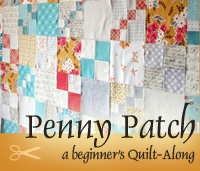 Now its time to get all your layers (quilt top, batting, backing) sandwiched together so that you can quilt your Penny Patch. Basting is the process of securing those layers together temporarily. Ideally, you baste "well" so that nothing shifts during quilting, causing frustrating puckers and such.
Now its time to get all your layers (quilt top, batting, backing) sandwiched together so that you can quilt your Penny Patch. Basting is the process of securing those layers together temporarily. Ideally, you baste "well" so that nothing shifts during quilting, causing frustrating puckers and such.
You can baste with pins, with needle & thread or with basting spray, but I think basting spray is easiest by far. Basting spray is a temporary adhesive spray designed for fabrics. A high-quality spray doesn't make a bit of gunky build-up. It's water soluble, so it washes right out when you wash your quilt.
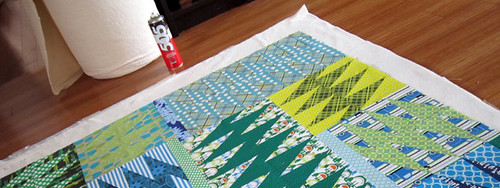
Amongst spray-basting quilters there seems to be an overwhelming majority who love 505 temporary adhesive spray. Me too! It works really well, which is key, but I also love that it is odorless and made in France, carrying no warning labels about using it outside or in a ventilated area. Most sprays have a strong odor, which is a telltale sign of toxicity. I'm not saying you should merrily inhale the stuff, but I feel good about using it in the house.
The only bummer is that spray (unlike basting pins) is not reusable. We are a family who's banished disposable plastics and papers from our kitchen. Heck, I even used cloth diapers, so it's not like I won't work for the sake of the environment. But basting spray is my exception. It just works so well and makes the process sooooooo fast.
Basting Spray Tutorial
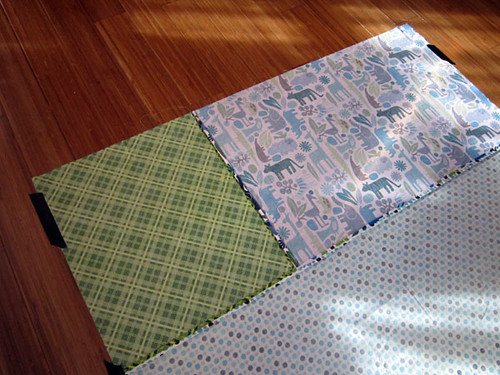
Tape your backing to the floor wrong side up with masking tape. Make it smooth, but not stretched.
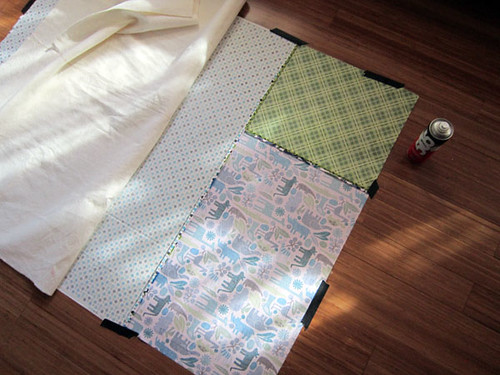
Lay out the batting smoothly. Then fold back half of the batting and spray the exposed backing with basting spray. Spray in a side to side sweeping motion, evenly covering, with the can at 12" from the backing. I've found that if I let the can drift farther from the fabric (say 18") the spray does not hold as well.
Replace the batting down on the backing, smoothing it out from the center to the edges. Repeat on opposite side to finish sticking the batting to the backing.

Now lay out the quilt top on the batting with right side up. Make it smooth and centered and straight as per the backing. I peak under the batting to see reference the backing at this point. Then fold back half of the quilt top and spray the exposed batting with basting spray. Remember to keep the can 12" from the batting as you sweep side to side, covering well with spray.
Replace the quilt top down on the batting, smoothing it out from the center to the edges. Repeat on opposite side to finish sticking the quilt top to the batting.
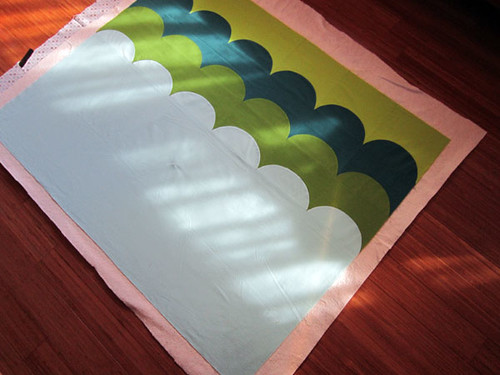
Easy! I can do this in about 15 minutes. If you've ever pin-basted, you know that's a quilting miracle. Then, remove the masking tape and !voila! all done.
More Basting Tips
**Some people say not to spray basting spray onto fabrics, just onto batting. I never have any trouble with my method, which does spray onto the backing fabric.
**Yes, some basting spray does get on my floors. It tracks onto my feet or socks. If you wear socks, you can get most of it up on your socks without trying and then wash the socks. I don't ever notice sticky spots on my floors the next day, except for at the very edges where no one walks. Residues easily wash off since the spray is water-soluble. To prevent residues you can first tape down a larger cloth for protection and then tape your backing to that cloth.
**Don't have a hard floor? What about a large table? Two tables pushed together? Or, tape a larger cloth to your carpet and then tape down your backing.
**Want to pin-baste? See this tutorial by Rita at Red Pepper Quilts.
**Careful basting with pins on carpet. They can easily get stuck right to the fibers of your carpet!
**There seem to be several types of 505 spray. I recommend the big RED can which is made in France and does not carry the "use with ventilation" warning label. As always, it never hurts to use caution and open windows!
**I buy my spray online at Sew for Less. They have the HUGE 17 oz can for about $13.00! I buy 2 cans at a time for $35, including shipping. Since I last purchased they changed the image to a yellow can. You may want to ask if this one is exactly the same as the red can and/or if they still stock the red can.
 Now its time to get all your layers (quilt top, batting, backing) sandwiched together so that you can quilt your Penny Patch. Basting is the process of securing those layers together temporarily. Ideally, you baste "well" so that nothing shifts during quilting, causing frustrating puckers and such.
Now its time to get all your layers (quilt top, batting, backing) sandwiched together so that you can quilt your Penny Patch. Basting is the process of securing those layers together temporarily. Ideally, you baste "well" so that nothing shifts during quilting, causing frustrating puckers and such.
You can baste with pins, with needle & thread or with basting spray, but I think basting spray is easiest by far. Basting spray is a temporary adhesive spray designed for fabrics. A high-quality spray doesn't make a bit of gunky build-up. It's water soluble, so it washes right out when you wash your quilt.

Amongst spray-basting quilters there seems to be an overwhelming majority who love 505 temporary adhesive spray. Me too! It works really well, which is key, but I also love that it is odorless and made in France, carrying no warning labels about using it outside or in a ventilated area. Most sprays have a strong odor, which is a telltale sign of toxicity. I'm not saying you should merrily inhale the stuff, but I feel good about using it in the house.
The only bummer is that spray (unlike basting pins) is not reusable. We are a family who's banished disposable plastics and papers from our kitchen. Heck, I even used cloth diapers, so it's not like I won't work for the sake of the environment. But basting spray is my exception. It just works so well and makes the process sooooooo fast.
Basting Spray Tutorial

Tape your backing to the floor wrong side up with masking tape. Make it smooth, but not stretched.

Lay out the batting smoothly. Then fold back half of the batting and spray the exposed backing with basting spray. Spray in a side to side sweeping motion, evenly covering, with the can at 12" from the backing. I've found that if I let the can drift farther from the fabric (say 18") the spray does not hold as well.
Replace the batting down on the backing, smoothing it out from the center to the edges. Repeat on opposite side to finish sticking the batting to the backing.

Now lay out the quilt top on the batting with right side up. Make it smooth and centered and straight as per the backing. I peak under the batting to see reference the backing at this point. Then fold back half of the quilt top and spray the exposed batting with basting spray. Remember to keep the can 12" from the batting as you sweep side to side, covering well with spray.
Replace the quilt top down on the batting, smoothing it out from the center to the edges. Repeat on opposite side to finish sticking the quilt top to the batting.

Easy! I can do this in about 15 minutes. If you've ever pin-basted, you know that's a quilting miracle. Then, remove the masking tape and !voila! all done.
More Basting Tips
**Some people say not to spray basting spray onto fabrics, just onto batting. I never have any trouble with my method, which does spray onto the backing fabric.
**Yes, some basting spray does get on my floors. It tracks onto my feet or socks. If you wear socks, you can get most of it up on your socks without trying and then wash the socks. I don't ever notice sticky spots on my floors the next day, except for at the very edges where no one walks. Residues easily wash off since the spray is water-soluble. To prevent residues you can first tape down a larger cloth for protection and then tape your backing to that cloth.
**Don't have a hard floor? What about a large table? Two tables pushed together? Or, tape a larger cloth to your carpet and then tape down your backing.
**Want to pin-baste? See this tutorial by Rita at Red Pepper Quilts.
**Careful basting with pins on carpet. They can easily get stuck right to the fibers of your carpet!
**There seem to be several types of 505 spray. I recommend the big RED can which is made in France and does not carry the "use with ventilation" warning label. As always, it never hurts to use caution and open windows!
**I buy my spray online at Sew for Less. They have the HUGE 17 oz can for about $13.00! I buy 2 cans at a time for $35, including shipping. Since I last purchased they changed the image to a yellow can. You may want to ask if this one is exactly the same as the red can and/or if they still stock the red can.